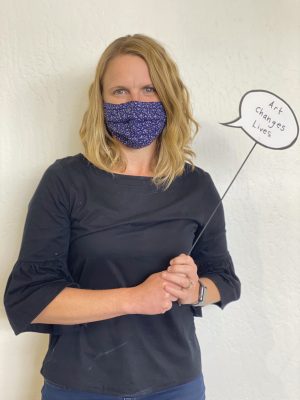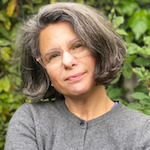Earlier this fall UPTAKE sat down with Kristen Jacobson, the recently hired executive director of Youth in Arts, to learn more about the organization and what’s in store for arts education in Marin.
My name is Kristen Jacobson. I’m the Executive Director of Youth in Arts.
Youth in Arts just celebrated its 50th anniversary. Primarily, we are a direct service provider to schools for arts education. We bring professional mentor artists in various disciplines (visual arts, performing arts including dance and music, and theater) to create bridges to creativity, confidence, and compassion for students as they move through their everyday experiences.
We also develop educators in differentiating teaching pedagogies to reach all students of all backgrounds and abilities and advocate locally and throughout the state and nation for equitable access to arts education.
Notably, Youth in Arts has been a primary site for the Kennedy center’s VSA or Very Special Arts Program since 1981, meaning that we are the sole provider of arts education for students with special needs and experiencing disabilities in Marin County.
We’re excited about a growing relationship with San Rafael City Schools through our Artists in Schools Program. One unique program in that umbrella is our partnership with Laurel Dell Elementary for six years, growing a sequential program from pre-K to fifth grade. Students explore identity, self, community, and relationship theories in the pre-K through second grade. And then, in third through fifth, they explore things like design, thinking, and solution making for their communities, and they do that with visual arts first, and then they do it with dance as well.
Our Arts Unite Us program is a significant partnership with the Marin County Office Of Education in special day classrooms. We partner with specific sites to infuse a mentor artist into the classroom so students experiencing disabilities and learning differences can have a robust arts education as part of their classroom experience.
‘Til Dawn is our teen mentoring program using music and a capella, music education. In its 26th year, ‘Til Dawn has 16 students from across Marin County. Students develop and experience the power of arts education and music and learning music together, just as a group while learning more about themselves.
We similarly convened youth this summer to address social justice and racism in Marin County. The youth created a design concept for a public art piece, and we’re partnering with the city of San Rafael right now to use that public art piece to reshape the public art approval in San Rafael.
I’ve been in arts education, basically my whole career, and it’s because of a belief that not every student learns at a desk facing forward. And that students need to access the information in different ways with their hands, body, voice, imagination, and the arts in various formats in various disciplines. Youth in Arts allows that to happen.
– Kristen Jacobson, Executive Director, Youth in Arts
When you ask that, the first two things that came to mind as significant challenges are COVID and funding. Marin has 18 school districts; Youth in Arts is working across all of them, and Richmond and West Contra Costa. It’s stressful keeping track of COVID protocols.
Funding feels different and more urgent coming off of pandemic relief and thinking about what our future looks like and sustainable ways to grow our programs thoughtfully. That keeps me up at night.
Youth in Arts impact is on the individual growth in the students. When students have access to creativity in their classroom, they understand more about who they are, the world around them, and how to stand up and advocate for their rights.
Looking at numbers, we work with about 15 to 20,000 students every year, depending on how we’re working that year. That’s a huge impact when you think about that. In many cases, students wouldn’t have access to an ongoing or recurring arts education if Youth in Arts wasn’t there.
There are so many ways that school districts cannot provide a robust arts education. You’re hearing a lot about school districts doing a volunteer curriculum where parents come in and teach art lessons.
Youth in Arts can come alongside, and partner with a school site to not just be the presence, but have professional artists come in and share their work, share their practice, and share their personal and who they are too, which is unique and magic.

One is a lovely student named Anna, who was in our ‘Til Dawn Program for the entirety of her high school career. She credits ‘Til Dawn, specifically the mentor artist Austin Willacy and his impact, with really guiding her formative years — understanding who she is, advocating for who she wants to be and what she wants, and asking tough questions about herself the people around her. Just seeing Anna’s ability to speak eloquently about the experience and the transformation, she speaks very eloquently about the ability to be mentored by a professional artist and a cohort of teens who were experiencing similar things she was, as she was developing and growing and learning.
Samuel, a student at Terra Linda High, is in the Arts Unite Us Program and recently won a congressional art contest for one of his pieces, which was pretty exciting. He is a young man developing his voice as an emerging artist, and his teachers have seen that growth because of the recurring visits of our mentor artists coming into his classroom. Our mission states that arts education is not just for those that can afford it or those that can access it in a typical way. So, it’s also for students that are neurodiverse and for students of every background and ability.
Jasmine is a rising fifth-grader at Laurel Dell Elementary. And she is a student that had an affinity for design and a passion for being an artist. And we also had Jasmine speak at our event. And one thing she noted about the impact of having a visiting artist in her classroom for now almost five years. She felt like her arts experience was where mistakes were okay, which was noteworthy. Mistakes can be used to find new solutions and a new creative pathway, which is astute for an almost fifth-grader to be able to realize on her own and point to as a valuable piece of her experience.
Our C-Street Project. This summer, as I mentioned, we convened ten youth through an application process under the mentorship of Orin Carpenter, who’s a pretty notable artist in the area. The group came together in response to a chalk mural created in Terra Linda commemorating the life and murder of Breonna Taylor: there was some community pushback and tension.
Long story short, Youth in Arts stepped in as the lead organization. We partnered with Orin Carpenter as a mentor artist to convene these youth, and then it came to fruition this summer.
And the cherry on top, we were able to raise enough money to pay and compensate the youth for participating. So, it became this remarkable triumvirate of a creative public art process, a mentoring experience for students. Working with a professional mentor artist and a job skills training program feels like an exciting new offshoot if you will, or model for Youth in Arts.
I’ve been in arts education, basically my whole career, and it’s because of a belief that not every student learns at a desk facing forward. And that students need to access the information in different ways with their hands, body, voice, imagination, and the arts in various formats in various disciplines. Youth in Arts allows that to happen.
My background is as a movement educator. I would come into a classroom and partner with a teacher or meet with a teacher ahead of time and lay out the creative process work that we would be doing. And a teacher would say, “This is going to be great, but you’re not going to like Johnny. Johnny’s going to be your problem student. He’s hard to control. I can’t get him to be quiet. He has outbursts.”
Nine times out of 10, Johnny was my star student because the teacher had done everything seemingly to reach that student except break them out of the pedestrian container that they were in being the desk or just the sitting or standing that they got to do, or the recess, right?
In accessing – or integrating, in my case – dance into the curriculum to say, learn about the galaxy, learn about simple machines, or learn about Math, Johnny became the star student. In those moments, that’s when you see the power of not just arts education, but in the understanding that we’re all human and multidimensional and don’t learn in a linear codified way. It just doesn’t happen like that.
So, I think why arts education truly reaches all students and makes learning engaging for students, and I’m a mom now, so when I see my kiddos become excited to go to school, that’s what you want, right? And that’s what teachers want.
I think breaking down the polarization between that arts need to become compartmentalized into a studio or a gallery. The arts can be integrated and infused into the student’s everyday experience but the teacher’s daily practice.
My background’s pretty interesting. I lived and worked in Chicago for a long time as both a teaching artist and a program designer and moved here seven years ago.
Now, I am living where I work. I can see through lines and connections to what we’re doing here (at Youth in Arts) and how that impacts my kids (at school) daily. And that’s the first time in my career that I’ve been able to see those connections. It’s pretty remarkable.

Pamela Coddington is a writer and editor. Full disclosure: She is a big supporter of the arts in Marin County and has done work with Youth in Arts, Image Flow Photography Center, di Rosa Center for Contemporary Art, Smith Andersen North, and Headlands Center for the Arts. Pamela is a graduate of New York University with a B.A. in Art History, and holds a post-baccalaureate degree in writing from U.C. Berkeley. Pamela lives and works in San Rafael with her family.